Teac Gf-680 User Manual
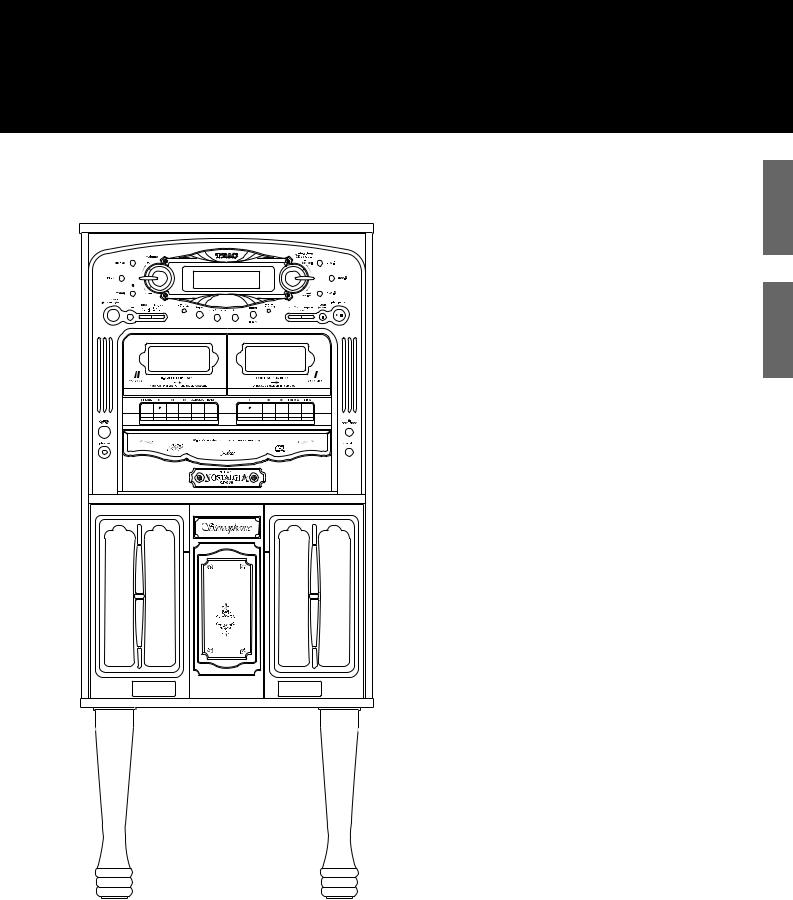
9A09897000
Z
GF-680
Compact Hi-Fi Stereo System
ENGLISH
OWNER’S MANUAL
MANUEL DU PROPRIÉTAIRE
FRANÇAIS

CAUTION: TO REDUCE THE RISK OF ELECTRIC SHOCK, DO NOT REMOVE COVER (OR BACK). NO USER-SERVICEABLE PARTS INSIDE. REFER SERVICING TO QUALIFIED SERVICE PERSONNEL.
The lightning flash with arrowhead symbol, within an equilateral triangle, is intended to alert the user to the presence of uninsulated "dangerous voltage" within the product’s enclosure that may be of sufficient magnitude to constitute a risk of electric shock to persons.
The exclamation point within an equilateral triangle is intended to alert the user to the presence of important operating and maintenance (servicing) instructions in the literature accompanying the appliance.
IMPORTANT SAFETY INSTRUCTIONS
1)Read these instructions.
2)Keep these instructions.
3)Heed all warnings.
4)Follow all instructions.
5)Do not use this apparatus near water.
6)Clean only with dry cloth.
7)Do not block any ventilation openings. Install in accordance with the manufacturer's instructions.
8)Do not install near any heat sources such as radiators, heat registers, stoves, or other apparatus (including amplifiers) that produce heat.
9)Do not defeat the safety purpose of the polarized or grounding-type plug. A polarized plug has two blades with one wider than the other. A grounding type plug has two blades and a third grounding prong. The wide blade or the third prong are provided for your safety. If the provided plug
does not fit into your outlet, consult an electrician for replacement of the obsolete outlet.
10)Protect the power cord from being walked on or pinched particularly at plugs, convenience receptacles, and the point where they exit from the apparatus.
11)Only use attachments/accessories specified by the
manufacturer.
12) Use only with the cart, stand, tripod, bracket, or table specified by the manufacturer, or sold with the apparatus. When a cart is used, use caution when moving the cart/apparatus combination to avoid injury from tip-over.
13)Unplug this apparatus during lightning storms or when unused for long periods of time.
14)Refer all servicing to qualified service personnel. Servicing is required when the apparatus has been damaged in any way, such as power-supply cord or plug is damaged, liquid has been spilled or objects have fallen into the apparatus, the apparatus has been exposed to rain or moisture, does not operate normally, or has been dropped.
<Do not expose this apparatus to dripps or splashes.
<Do not place any objects filled with liquids, such as vases, on the apparatus.
<Do not install this apparatus in a confined space such as a book case or similar unit.
<The apparatus draws nominal non-operating power from the AC outlet with its POWER switch in the off position.
WARNING : TO PREVENT FIRE OR SHOCK HAZARD, DO NOT EXPOSE THIS APPLIANCE TO RAIN OR MOISTURE.
CAUTION
<DO NOT REMOVE THE PROTECTIVE HOUSING USING SCREWDRIVER.
<USE OF CONTROLS OR ADJUSTMENTS OR PERFORMANCE OF PROCEDURES OTHER THAN THOSE SPECIFIED HEREIN MAY RESULT IN HAZARDOUS RADIATION EXPOSURE.
<IF THIS PRODUCT DEVELOPS TROUBLE, MAKE A CONTACT WITH OUR SERVICEMAN, AND DO NOT USE THE PRODUCT IN A TROUBLED STATE.
For U.S.A.
This equipment has been tested and found to comply with the limits for a Class B digital device, pursuant to Part 15 of the FCC Rules. These limits are designed to provide reasonable protection against harmful interference in a residential installation. This equipment generates, uses, and can radiate radio frequency energy and, if not installed and used in accordance with the instructions, may cause harmful interference to radio communications. However, there is no guarantee that interference will not occur in a particular installation. If this equipment does cause harmful interference to radio or television reception, which can be determined by turning the equipment off and on, the user is encouraged to try to correct the interference by one or more of the following measures:
•Reorient or relocate the equipment and/or the receiving antenna.
•Increase the separation between the equipment and receiver.
•Connect the equipment into an outlet on a circuit different from that to which the receiver is connected.
•Consult the dealer or an experienced radio/TV technician for
help.
CAUTION
Changes or modifications to this equipments not expressly approved by TEAC CORPORATION for compliance will void the user's warranty.
For CANADA
AC POWER CORD CONNECTION
CAUTION:
TO PREVENT ELECTRIC SHOCK, MATCH WIDE BLADE OF PLUG TO WIDE SLOT, FULLY INSERT.
Pour le CANADA
CORDE DE CONNEXION CA
ATTENTION:
POUR ÉVITER LES CHOCS ÉLECTRIQUES, INTRODUIRE LA LAME LA PLUS LARGE DE LA FICHE DANS LA BORNE CORRESPONDANTE DE LA PRISE ET POUSSER JUSQU’AU FOND.
2
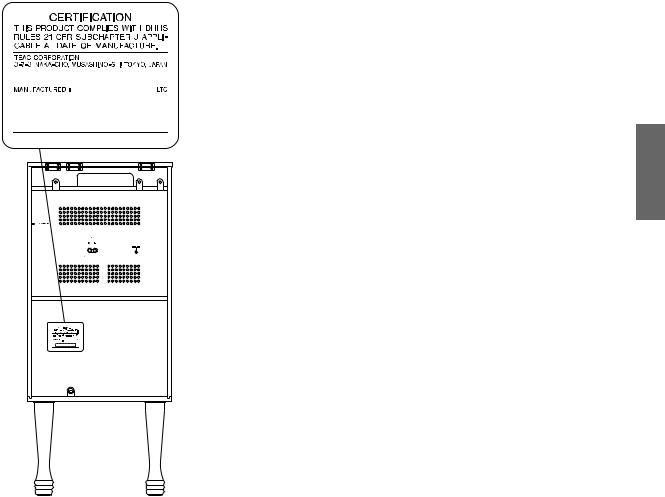
This product has been designed and manufactured according to FDA regulations “title 21, CFR, chapter 1, subchapter J, based on the Radiation Control for Health and Safety Act of 1968“, and is classified as class 1 laser product. There is not hazardous invisible laser radiation during operation because invisible laser radiation emitted inside of this product is completely confined in the protective housings.
The label required in this regulation is shown .
For U.S.A.
ENGLISH
Optical pickup : |
|
|
Type |
: |
SLD104u |
Manufacturer |
: |
SONY Corporation |
Laser output |
: Less than 0.5 mW on the objective lens |
|
Wavelength |
: |
760 - 800 nm |
|
|
|
3

Contents
Thank you for choosing TEAC. Read this manual carefully to get the best performance from this unit.
Important Safety Instructions . . . . . . . . . . . . . . . . . . . . . . . . . . . . . |
. 2 |
Contents . . . . . . . . . . . . . . . . . . . . . . . . . . . . . . . . . . . . . . . . . . . . . . . . |
. 4 |
Before Use. . . . . . . . . . . . . . . . . . . . . . . . . . . . . . . . . . . . . . . . . . . . . . . |
. 4 |
Discs. . . . . . . . . . . . . . . . . . . . . . . . . . . . . . . . . . . . . . . . . . . . . . . . . . . . |
. 5 |
Cassette Tape . . . . . . . . . . . . . . . . . . . . . . . . . . . . . . . . . . . . . . . . . . . . |
. 6 |
Handling Records . . . . . . . . . . . . . . . . . . . . . . . . . . . . . . . . . . . . . . . . |
. 7 |
How to Replace the Stylus . . . . . . . . . . . . . . . . . . . . . . . . . . . . . . . . . |
. 7 |
Connection . . . . . . . . . . . . . . . . . . . . . . . . . . . . . . . . . . . . . . . . . . . . . . |
. 8 |
Remote Control Unit. . . . . . . . . . . . . . . . . . . . . . . . . . . . . . . . . . . . . . . |
. 9 |
Names of Each Control (Front Panel/Remote Control Unit) . . . . . |
10 |
Names of Each Control (Turntable). . . . . . . . . . . . . . . . . . . . . . . . . . |
12 |
Basic Operation . . . . . . . . . . . . . . . . . . . . . . . . . . . . . . . . . . . . . . . . . . |
13 |
Listening to a Record. . . . . . . . . . . . . . . . . . . . . . . . . . . . . . . . . . . . . . |
14 |
Listening to CDs . . . . . . . . . . . . . . . . . . . . . . . . . . . . . . . . . . . . . . . . . . |
16 |
Programmed Playback . . . . . . . . . . . . . . . . . . . . . . . . . . . . . . . . . . . . |
18 |
Intro Check . . . . . . . . . . . . . . . . . . . . . . . . . . . . . . . . . . . . . . . . . . . . . . |
19 |
Shuffle Playback. . . . . . . . . . . . . . . . . . . . . . . . . . . . . . . . . . . . . . . . . . |
20 |
Repeat Playback. . . . . . . . . . . . . . . . . . . . . . . . . . . . . . . . . . . . . . . . . . |
20 |
Listening to the Radio . . . . . . . . . . . . . . . . . . . . . . . . . . . . . . . . . . . . . |
21 |
Preset Tuning . . . . . . . . . . . . . . . . . . . . . . . . . . . . . . . . . . . . . . . . . . . . |
22 |
Listening to Tapes . . . . . . . . . . . . . . . . . . . . . . . . . . . . . . . . . . . . . . . . |
23 |
Extended Playback. . . . . . . . . . . . . . . . . . . . . . . . . . . . . . . . . . . . . . . . |
24 |
Recording . . . . . . . . . . . . . . . . . . . . . . . . . . . . . . . . . . . . . . . . . . . . . . . |
24 |
Dubbing (Copy from TAPE ! to TAPE @) . . . . . . . . . . . . . . . . . . . . . . |
25 |
Setting the Clock . . . . . . . . . . . . . . . . . . . . . . . . . . . . . . . . . . . . . . . . . |
26 |
Setting the Timer . . . . . . . . . . . . . . . . . . . . . . . . . . . . . . . . . . . . . . . . . |
27 |
Timer Playback . . . . . . . . . . . . . . . . . . . . . . . . . . . . . . . . . . . . . . . . . . . |
28 |
Timer Recording . . . . . . . . . . . . . . . . . . . . . . . . . . . . . . . . . . . . . . . . . . |
29 |
Display . . . . . . . . . . . . . . . . . . . . . . . . . . . . . . . . . . . . . . . . . . . . . . . . . . |
29 |
Troubleshooting . . . . . . . . . . . . . . . . . . . . . . . . . . . . . . . . . . . . . . . . . . |
30 |
Specifications . . . . . . . . . . . . . . . . . . . . . . . . . . . . . . . . . . . . . . . . . . . . |
31 |
Before Use
Read this before operation
<As the unit may become warm during operation, always leave sufficient space around the unit for ventilation.
<The voltage supplied to the unit should match the voltage as printed on the rear panel. If you are in any doubt regarding this matter, consult an electrician.
<Choose the installation location of your unit carefully. Avoid placing it in direct sunlight or close to a source of heat. Also avoid locations subject to vibrations and excessive dust, heat, cold or moisture.
<Do not place the unit on an amplifier/receiver or any other electronic device that generates heat.
<Do not open the sealed cabinet as this might result in damage to the circuitry or electrical shock. If a foreign object should get into the set, contact your dealer or service agency.
<When removing the power plug from the wall outlet, always pull directly on the plug, never yank the cord.
<To keep the laser pickup clean, do not touch it, and always close the disc tray.
<Do not attempt to clean the unit with chemical solvents as this might damage the finish. Use a clean, dry cloth.
<Keep this manual in a safe place for future reference.
DO NOT MOVE THE UNIT DURING PLAYBACK
During playback, the disc rotates at high speed. Do NOT lift or move the unit during playback. Doing so may damage the disc or the record.
WHEN MOVING THIS UNIT
When changing places of installation or packing the unit for moving, be sure to remove the disc and the record. Moving this unit with the disc or the record loaded may result in damage to this unit. If the unit is to be packed and moved a large distance, it is also advisable to tighten the turntable transport locking screw. See page 12 for instructions.
Beware of condensation
When the unit (or a disc) is moved from a cold to a warm place, or used after a sudden temperature change, there is a danger of condensation; vapor in the air could condense on the internal mechanism, making correct operation erratic or impossible. To prevent this, or if this occurs, leave the unit for one or two hours with the power turned on. The unit will stabilize at the temperature of its surroundings.
Maintenance
Always keep the turntable clean.
If the surface of the unit gets dirty, wipe with a soft cloth or use diluted mild liquid soap. Be sure to remove any excess completely. Do not use thinner, benzine or alcohol as they may damage the surface of the unit. Allow the surface of the unit to dry completely before using
CAUTION
Do not expose this unit to liquids of any kind. Keep any objects containing liquids such as vases, water glasses, potted plants, et cetera off the top of this unit.
Do not install this equipment in a confined space such as a book-case or similar unit.
4
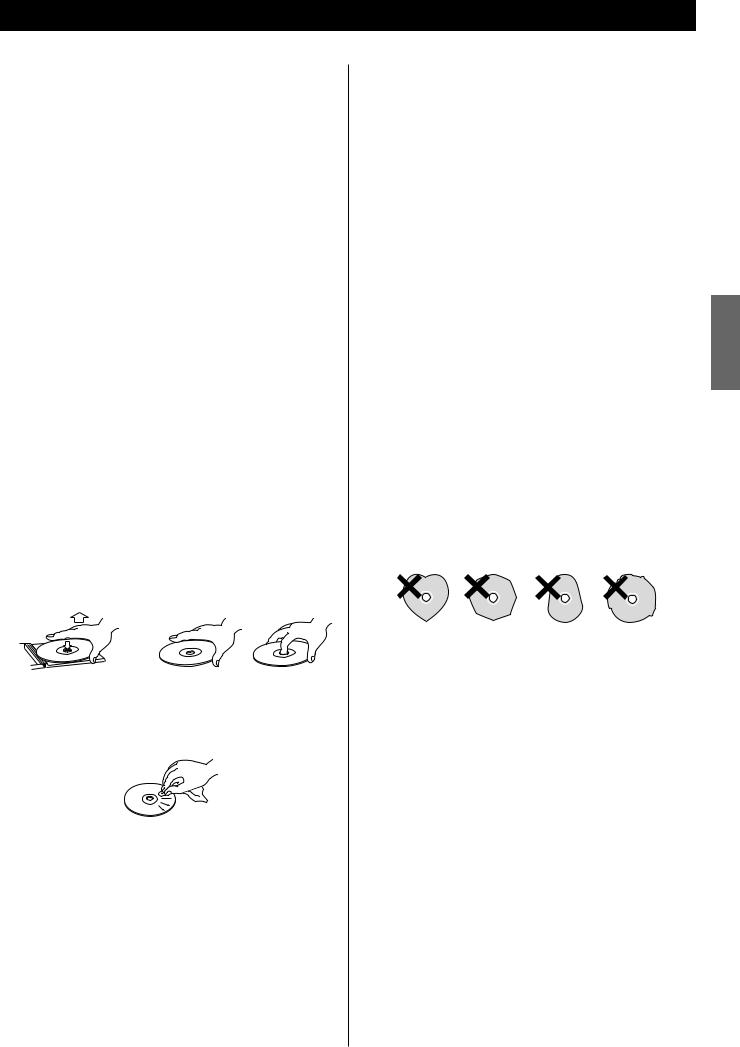
Discs
Discs which can be played on this unit: |
< Never use such chemicals as record sprays, antistatic sprays |
• Conventional audio CDs bearing the CD-DA logo on the |
or fluid, benzine or thinner to clean the discs. Such chemicals |
will do irreparable damage to the disc's plastic surface. |
|
label: |
|
?< Discs should be returned to their cases after use to avoid dust and scratches that could cause the laser pickup to "skip."
<Do not expose discs to direct sunlight or high humidity and
• Properly finalized CD-R discs |
temperature for extended periods. Long exposure to high |
|||||
temperatures will warp the disc. |
||||||
Note: |
< CD-R discs are more sensitive to the effects of heat and |
|||||
ultraviolet rays than ordinary CDs. It is important that they are |
||||||
< Depending on the quality of the disc and/or the condition of the |
not stored in a location where direct sunlight will fall on them, |
|||||
recording, some CD-R discs may not be playable. |
and which is away from sources of heat such as radiators or |
|||||
< CD-RW discs cannot be played on this unit. |
heat-generating electrical devices. |
|||||
< Copy-protected discs and other discs which do not conform to |
|
|
|
|
|
|
the CD standard may not play back correctly in this player. |
< Printable CD-R discs aren't recommended, as the label side |
|||||
If you use such discs in this unit, TEAC Corporation and its |
might be sticky and damage the unit. |
|||||
subsidiaries cannot be responsible for any consequences or |
|
|
|
|
|
|
guarantee the quality of reproduction. If you experience |
< Do not stick papers or protective sheets on the discs and do |
|||||
problems with such non-standard discs, you should contact |
not use any protective coating spray. |
|||||
the producers of the disc. |
|
|
|
|
|
|
|
< Use a soft oil-based felt-tipped pen to write the information on |
|||||
|
the label side. Never use a ball-point or hard-tipped pen, as |
|||||
|
this may cause damage to the recorded side. |
|||||
|
< Never use a stabilizer. Using commercially available CD |
|||||
< Always place the disc on the disc tray with the label side |
stabilizers with this unit will damage the mechanisms and |
|||||
cause them to malfunction. |
||||||
uppermost. (Compact discs can be played or recorded only on |
|
|
|
|
|
|
one side.) |
< Do not use irregular shape CDs (octagonal, heart-shape, etc.). |
|||||
< To remove a disc from its storage case, press down on the |
CDs of this sort can damage the unit. |
|||||
|
|
|
|
|
|
|
center of the case and lift the disc out, holding it carefully by |
|
|
|
|
|
|
the edges. |
|
|
|
|
|
|
|
|
|
|
|
|
|
|
|
< If you are in any doubt as to the care and handling of a CD-R |
|
|
disc, read the precautions supplied with the disc, or contact |
How to remove the disc |
How to hold the disc |
the disc manufacturer directly. |
|
<Should the disc become dirty, wipe the surface radially with a soft, dry cloth.
ENGLISH
5
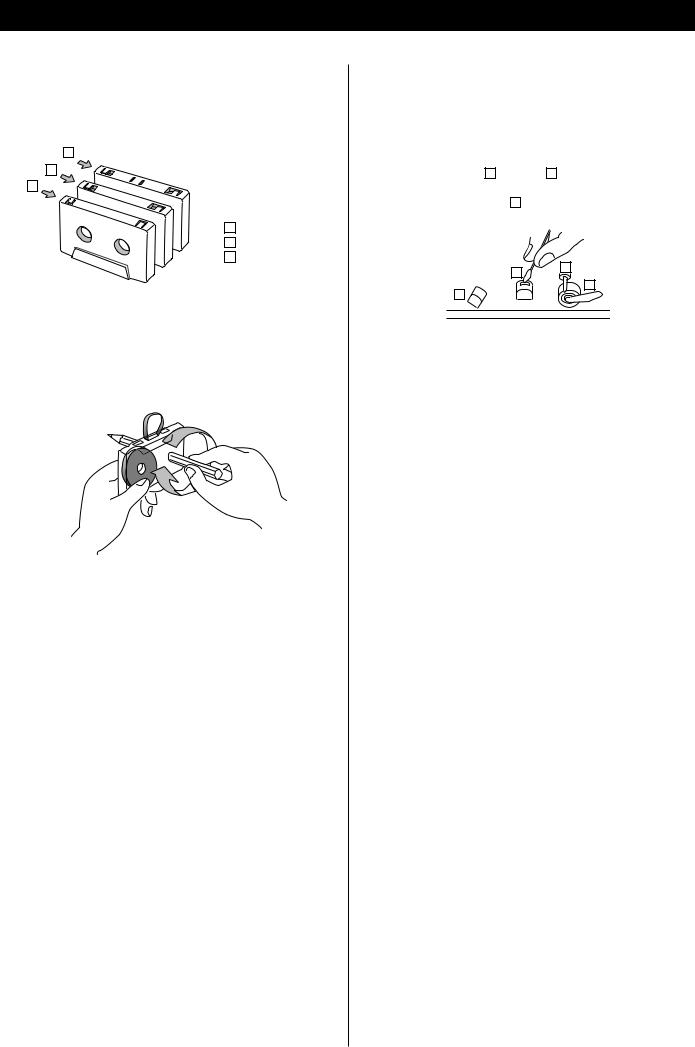
Cassette Tape
Tape Selection
Metal and chrome (cobalt) tapes have identification holes.
< This unit can play normal (Type!) tape only.
c
b
a
a Normal (Type!)
b CrO2 (Type@)
c Metal (Type!%)
Tape Handling
Use your finger or a pencil to turn the cassette's hub and take up any slack tape.
< Avoid touching the tape. Fingerprints attract dust and dirt.
Do not store tapes in the following places:
<On top of heaters, exposed to direct sunlight or in any other places with high temperatures.
<Near speakers, on TV sets or amplifiers or where they would be exposed to strong magnetic fields.
<Where humidity is high and in dirty, dusty places.
<Avoid dropping or subjecting cassettes to excessive shocks.
<As C-120 tapes are physically weak and could become entangled in the transport mechanism, do not use them.
Maintenance
The heads and tape path should be cleaned and demagnetized periodically.
Cleaning Tape Path
<Apply head cleaning fluid to a cotton swab or soft cloth, and lightly rub the heads A , capstan B and all metal parts in the tape path.
<Also clean the pinch roller C using rubber cleaning fluid.
(TAPE @ only) A |
B |
|
C |
||
|
A
Demagnetizing Heads
Be sure that the power is off, then demagnetize the heads using a demagnetizer. For details of its use, read its instructions.
6
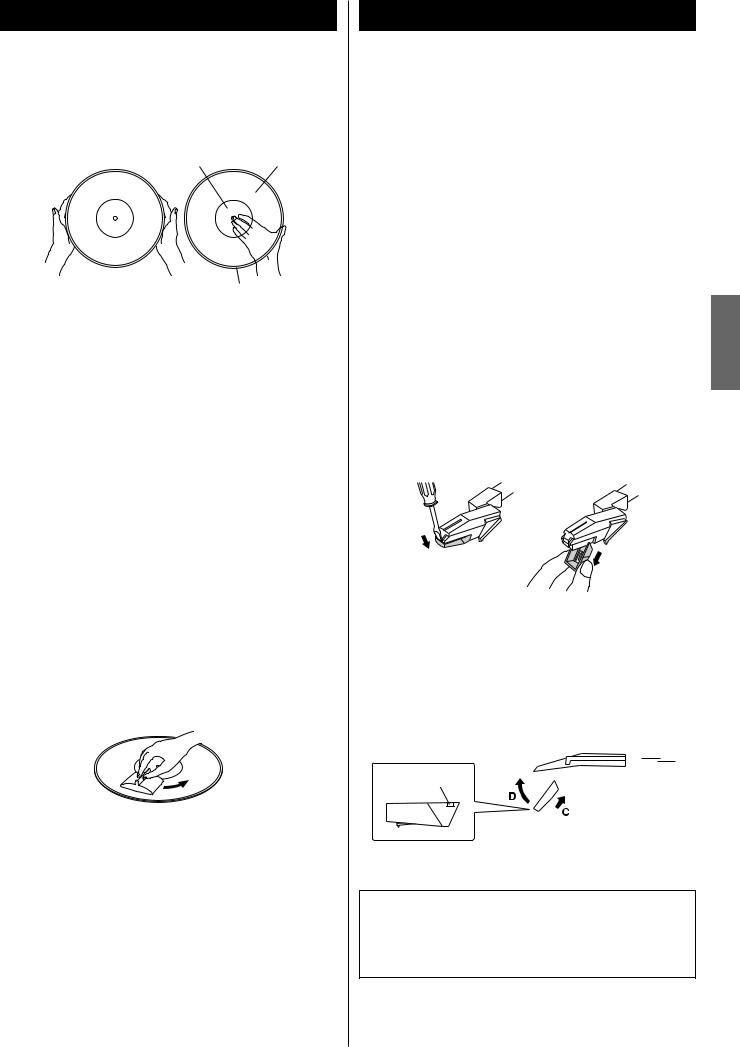
Handling Records
<Do not touch grooves. Handle records by the edges or the label only, with clean hands. Skin oils from even clean hands can leave a residue on the record surface that will gradually deteriorate the quality of your record.
label |
grooves |
edge
<Keep your records away from dust. Keep them in a cool, dry place.
<To avoid dust and scratches, keep records in their sleeves and jackets when not in use.
<Store records upright on their edges. Records stored horizontally will eventually bend and warp.
<Do not expose records to direct sunlight or high humidity and temperature. Long exposure to high temperatures will warp the record.
<Do not store your records in the trunk of your car. The temperatures in a closed trunk can ruin your collection.
<Store records in an area with stable temperature and humidity.
<Should the record become dirty, gently wipe the surface in a circular motion, using a soft anti-static cloth.
Many commercial record cleaning systems are available from many retailers or on-line. TEAC does not endorse any specific product but, depending on the condition of your record collection, it may be advisable to look into one of these systems. Clean records protect your stylus from undue wear.
How to Replace the Stylus
Stylus should last about 50 hours under normal use. However, it is recommended to replace the stylus as soon as you notice a change in sound quality.
Prolonged use of a worn-out stylus may damage the record. Wear and tear will accelerate when playing 78 RPM records. The higher speed of 78 RPM records wears the stylus more quickly.
Caution:
< Do not remove or bend stylus.
< To avoid injury, do not touch the needle.
< Turn off the power of the unit before you replace the stylus. < Keep out of reach of children.
< Handle with care, as the stylus is delicate. Use of a bent or broken stylus may damage the record and cause mal-function.
< Do not expose stylus to extreme heat.
< Contact a qualified repair company if you experience difficulty in changing the stylus.
ENGLISH
Removing old stylus
1.Set a screwdriver at the tip of stylus and push down to the direction “A”.
2.Pull out to the direction “B”.
A
B
Installing new stylus
1.Hold the tip of stylus and insert the other edge to the direction
“C”.
2.Push up to the direction “D” until it locks at the tip. Guide Pins (inside) 


The replacement stylus for this GF-600 is a STL-103. Please contact TEAC Parts at (323) 726-0303, extension 840 to order. Or call our automated Service Agency Locator at: (800) 447-TEAC for the closest authorized repair company that can replace the stylus for you.
7
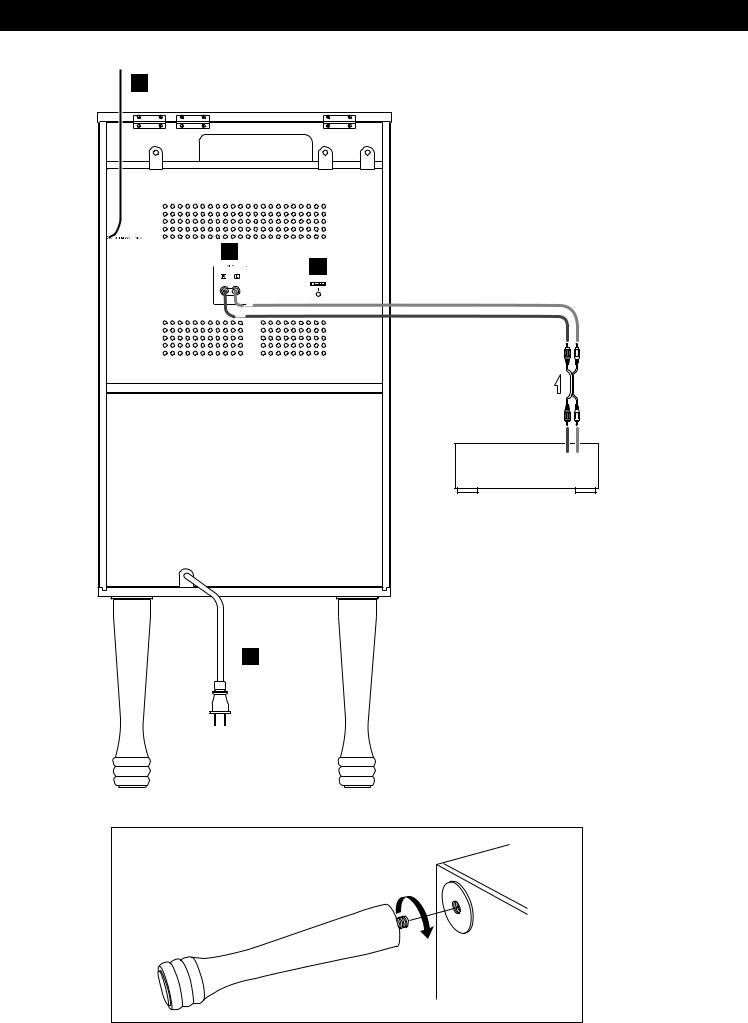
Connection |
A |
B |
D |
C |
R L
LINE OUT
DVD, CD-R, etc.
Installing the legs
Bottom of the unit
8
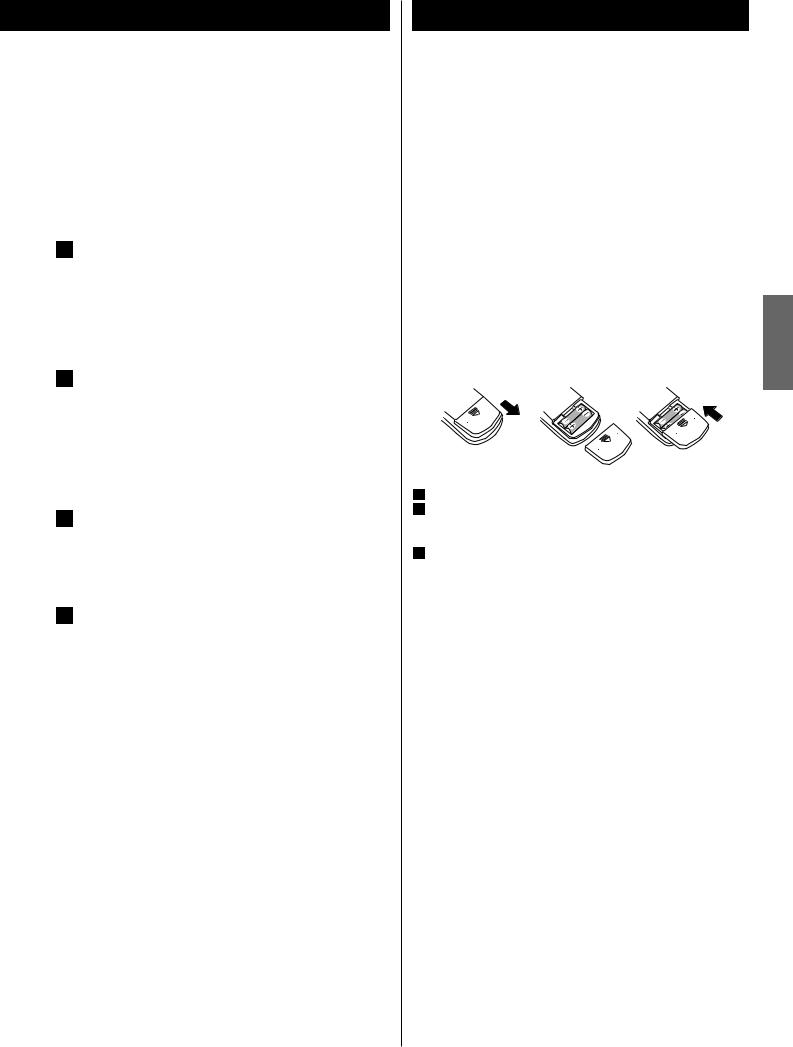
CAUTION
Turn off the power of all the equipment before making connections.
Read instructions of each component you intend to use with this unit.
<Be sure to insert each plug securely. To prevent hum and noise, do not bundle the connection cords with the power cord.
A FM antenna
While in FM mode, tune in an FM station and extend the lead to find the best position for reception. This antenna may need to be repositioned if you move your unit to a new location.
B AUX
You can connect a DVD player, VCR etc. to this unit. Connect the component with RCA pin cords. Make sure to connect the white plug to the white jacks (Left) and the red plug to the red jacks (Right).
C AC Power Cord
Plug this AC power cord into an AC wall socket.
D RESET
In the following cases, function buttons may not work properly.
•When the system is damaged by some electrical shock.
•When the power is irregular or has electrical noises.
In these cases, press the RESET switch once or twice with a pencil or a ball-point pen lightly.
Remote Control Unit
The provided Remote Control Unit allows the unit to be operated from a distance.
When operating the remote control unit, point it towards the REMOTE SENSOR on the front panel of the unit.
<Even if the remote control unit is operated within the effective range, remote control operation may be impossible if there are any obstacles between the unit and the remote control.
<If the remote control unit is operated near other products which generate infrared rays, or if other remote control devices using infrared rays are used near the unit, it may operate incorrectly. Conversely, the other products may operate incorrectly.
Battery Installation
1 |
2 |
3 |
1Remove the battery compartment cover.
2Insert two “AAA“ (R03, UM-4) dry batteries. Make sure that the batteries are inserted with their positive “+“ and negative “_“ poles positioned correctly.
3Close the cover.
Battery Replacement
If the distance required between the remote control unit and main unit decreases, the batteries are exhausted. In this case replace the batteries with new ones.
Precautions concerning batteries
<Be sure to insert the batteries with correct positive “+“ and negative “_“ polarities.
<Use batteries of the same type. Never use different types of batteries together.
<Rechargeable and non-rechargeable batteries can be used. Refer to the precautions on their labels.
<When the remote control unit is not to be used for a long time (more than a month), remove the batteries from the remote control unit to prevent them from leaking. If they leak, wipe away the liquid inside the battery compartment and replace the batteries with new ones.
<Do not heat or disassemble batteries and never dispose of old batteries by throwing them in a fire.
ENGLISH
9
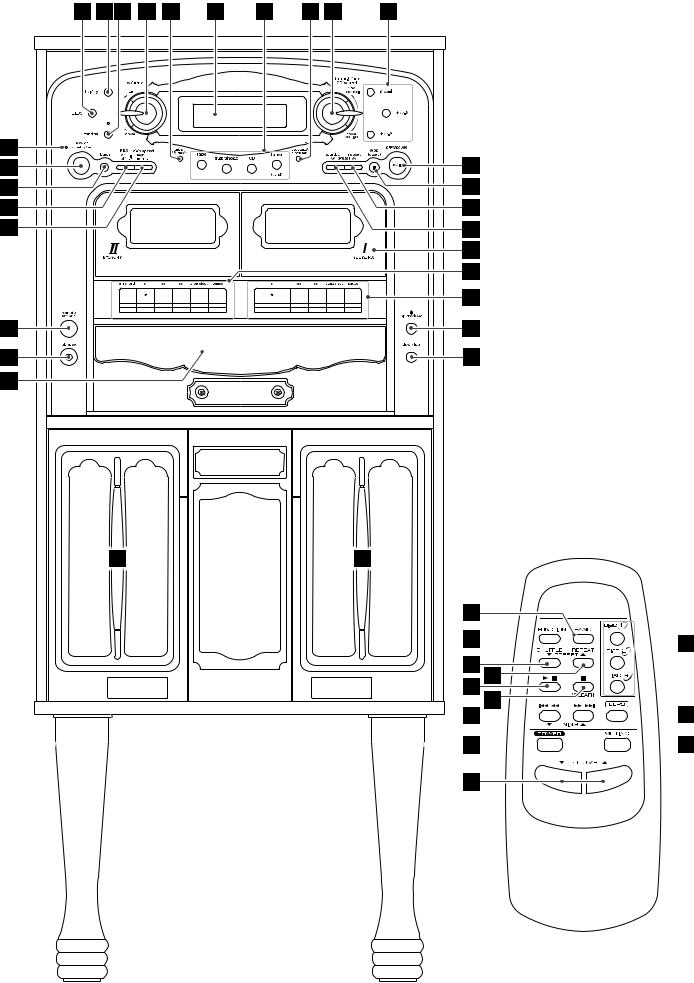
a Z Y X W |
V |
U |
T S |
R |
A |
|
|
|
Q |
B |
|
|
|
|
C |
|
|
|
P |
D |
|
|
|
O |
E |
|
|
|
N |
|
|
|
|
M |
|
|
|
|
L |
|
|
|
|
K |
F |
|
|
|
J |
G |
|
|
|
I |
H |
|
|
|
|
b |
b |
Remote control unit
c
U
 R
R
N
Q O P
S 
 a
a
B
 Y
Y
X
10
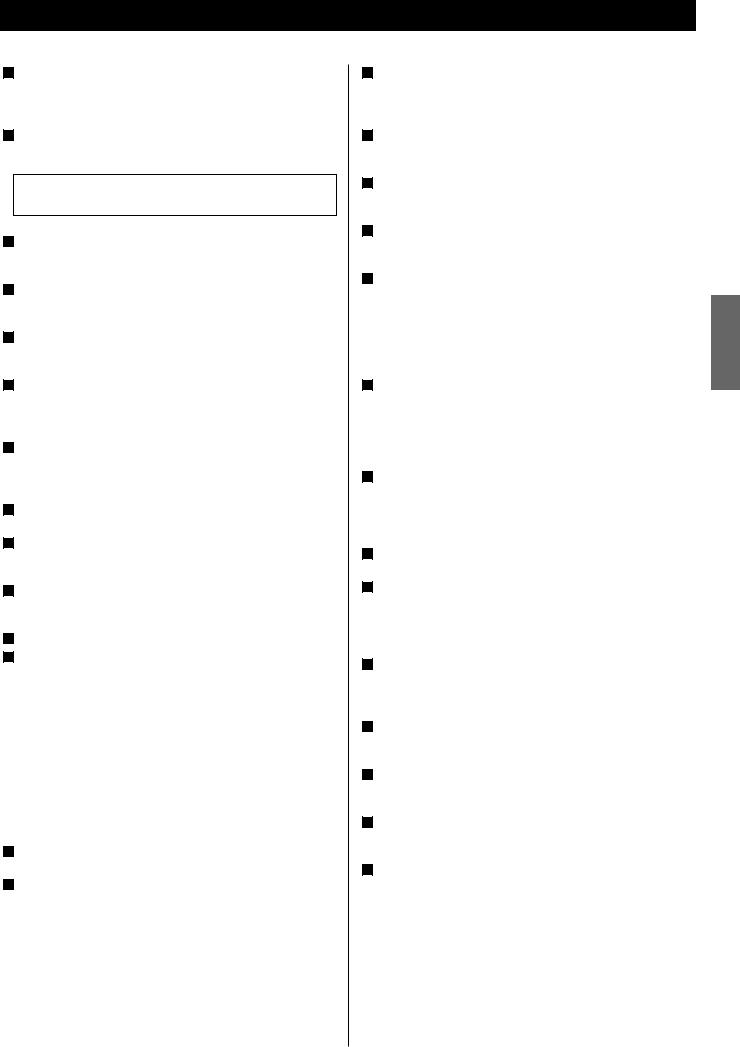
Names of Each Control (Front Panel/Remote Control Unit)
ASTANDBY indicator
This indicator lights when the unit is in the standby mode. When the unit is turned on, the light goes off.
BPOWER
Press this switch to turn the unit on or off (standby).
The equipment draws a nominal amount of power from the AC outlet even with its POWER switch in the OFF position.
CTIMER
Use this button to set the timer.
DBBS
Use this button to boost bass.
EDUB SPEED
Use this button to select the dubbing speed.
FREMOTE SENSOR
When operating the remote control unit, point it towards the REMOTE SENSOR.
GPHONES
For private listening, insert the headphones plug into this jack, and adjust the volume by turning the VOLUME knob.
HDisc tray
IDISC SKIP
Use this button to rotate the carousel.
JOPEN/CLOSE
Use this button to open and close the disc tray.
K TAPE ! operation buttons
LTAPE @ operation buttons
PLAY :
Use this button to start playback of the tape.
SEARCH :
Use these buttons to fast-forward or rewind the tape.
STOP/EJECT :
Use this button to stop playback. In the stop mode, use this button to open the cassette holder.
PAUSE :
Use this button to pause playback.
RECORD :
Use this button to start recording.
MCassette holder
NSHUFFLE/PRESET
In CD mode, use this button for shuffle playback.
In TUNER mode, use this button to select preset stations.
OREPEAT/PRESET
In CD mode, use this button for repeat playback.
In TUNER mode, use this button to select preset stations.
PSTOP
Use this button to stop playback of CD.
QPLAY
Use this button to start or pause playback of CD.
RDISC 1, 2, 3
Use these buttons to select a disc.
SCD SEARCH/TUNING/TIME (.m/,/)
In CD mode, momentarily turn this knob (or press the SKIP button of the remote control unit) to skip tracks. Hold up or down the knob (or press and hold the SKIP button) to search for a part of a track.
In TUNER mode, momentarily turn this knob to tune in stations.
TPROGRAM/CLOCK ADJ
In CD mode, use this button to program tracks.
In TUNER mode, use this button to store preset channels into memory.
This button is also used for clock adjustment.
UFUNCTION (TAPE, AUX/PHONO, CD, TUNER)
Use these buttons to select a source.
In TUNER mode, press the TUNER (BAND) button to select FM or AM.
VDisplay
WINTRO/FM MODE
In CD mode, use this button to start intro check.
In FM TUNER mode, use this button to select stereo or monaural.
XVOLUME
Turn this knob (or press the VOLUME buttons of the remote control unit) to adjust the volume.
YMUTING
Use this button to mute the sound.
ZDISPLAY
Use this button to change the display.
aEEPS
Use this button to select a preset equalizer.
bSpeakers (stereo)
Note:
To simplify explanations, instructions refer to names of buttons and controls on the front panel, making no mention of the use of remote control unit.
ENGLISH
11
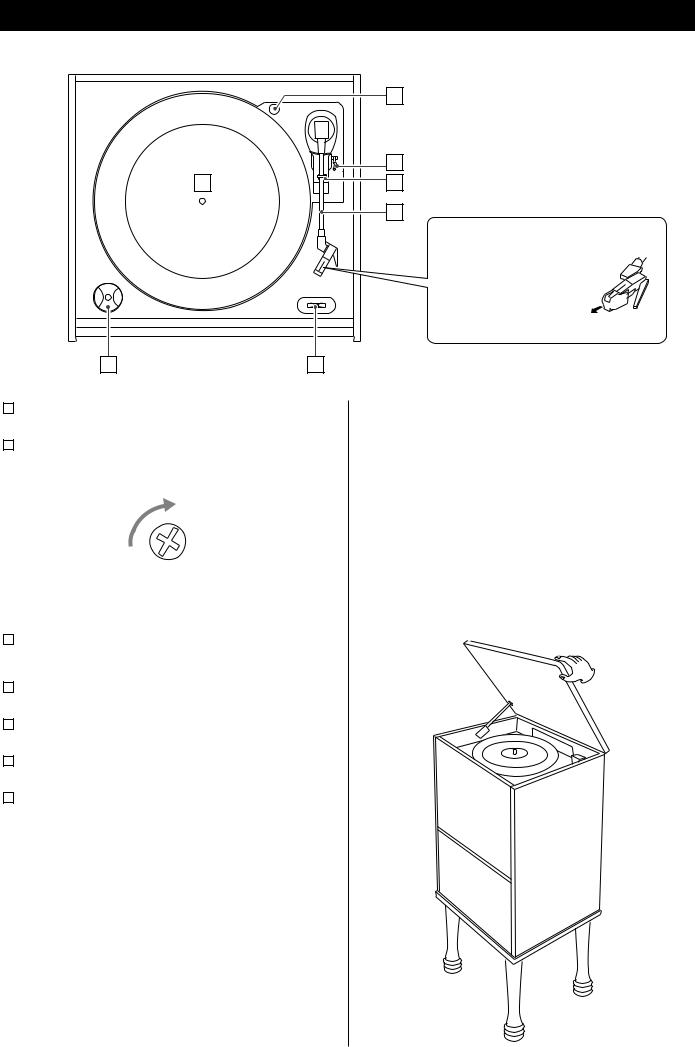
Names of Each Control (Turntable)
|
B |
|
C |
A |
D |
|
E |
G |
F |
Before use, detach the stylus guard (white plastic cover) by pulling it straight off the front of the cartridge in the direction of the arrow.
Aturntable
Bscrew fixing the turntable for transportation
Before use, completely loosen the screw by turning it clockwise with a coin or screwdriver.
When you transport the unit, turn the screw counterclockwise to fix the turntable.
Ccue-lever
Use this lever to lift the tone arm.
How to open/close the turntable cover
To Open:
1.Lift the turntable cover all the way up until it stops.
2.Lower the cover slowly until the latch engages.
3.The cover will now stay open. If the latch does not engage, repeat these steps again.
To Close:
1.Lift the cover all the way up until it stops.
2.The latch should disengage and you may now slowly lower the cover.
3.Make sure you grasp the cover by the edges to avoid pinching yourfingers as it closes.
Dtone arm holder
Etone arm
F speed selector
G 45 RPM adaptor
12
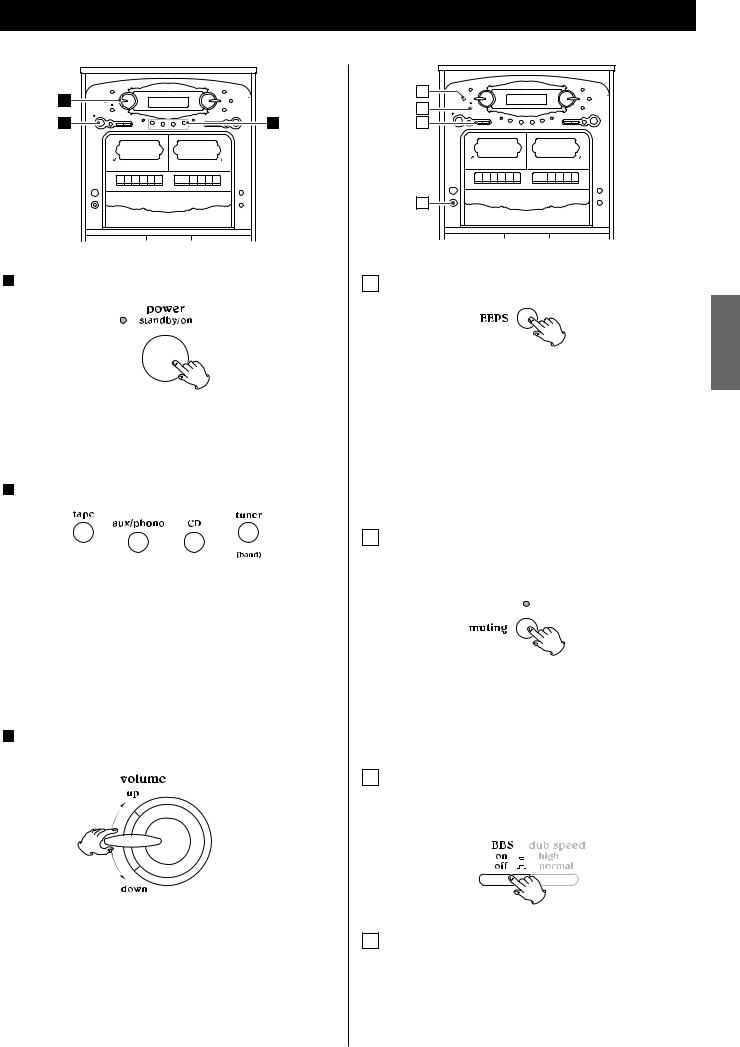
Basic Operation
3
1 |
2 |
1 Press the POWER switch to turn the unit on.
The standby indicator goes off.
<When the unit is turned on, the MUTING indicator lights momentarily. This is not a malfunction.
2 Select a source by pressing the corresponding button.
<When using the remote control unit, press the FUNCTION button repeatedly until the desired source appears on the display.
<To listen to an external source connected to AUX jacks, press the AUX/PHONO button.
<If you play an external source and a record simultaneously, the sound will be mixed.
3Play the source, and adjust the volume by turning the VOLUME knob.
A
B
C
D
A EEPS (Electronic Equalizer Preset System)
Each time the EEPS button is pressed, the mode is changed |
ENGLISH |
as follows: |
|
CLASSIC: A balanced sound; suitable for classical music. ROCK: Provides a heavy powerful sound; suitable for rock music.
POPS: Emphasizes vocal tones; suitable for popular music. FLAT: EEPS is off.
B Muting
To mute the sound temporarily, press the MUTING button. Press the MUTING button again to restore the sound.
<While muting is engaged, the muting indicator lights.
<The muting indicator also lights in the stop or pause mode of CD, even when the muting isn't selected. When the PLAY button is pressed, it goes off.
C Bass Boost System
To emphasize bass, press the BBS button. Press the button again to turn it off.
D Headphones
For private listening, insert the headphones plug into the PHONES jack, and adjust the volume by turning the VOLUME knob. The sound from the speakers is cut off while the headphone jack is inserted.
13
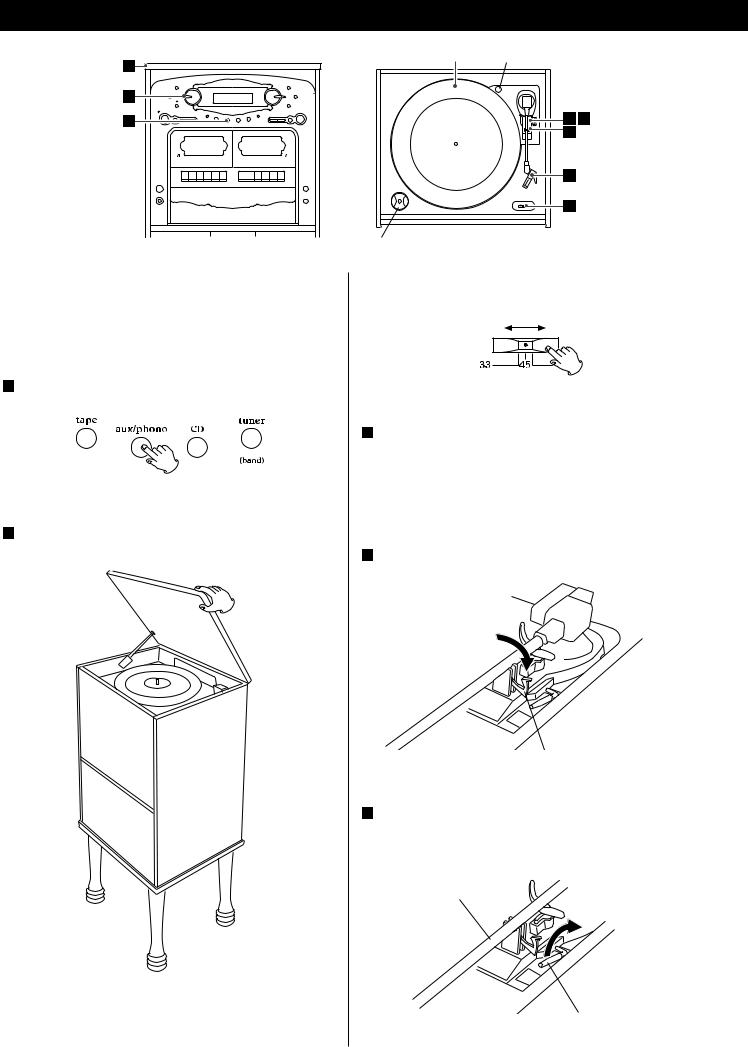
Listening to a Record
2 |
9 |
1 |
4 |
transportation screw |
6 8 |
5 |
7 |
3 |
adaptor
Before use, completely loosen the transportation screw by |
3 |
Select the speed. |
turning it clockwise with a coin. |
|
|
Detach the stylus guard (white plastic cover). |
|
|
1 Press the AUX/PHONO button.
4 Put the record on the turntable.
When playing a 45 RPM record, use the included adaptor.
2Gently open the turntable cover. Be careful not to pinch your finger.
5 Gently push the clamper to the right to release the tone arm.
clamper
6Raise the cue lever to lift the tone arm off the tone arm support.
tone arm
cue lever
14
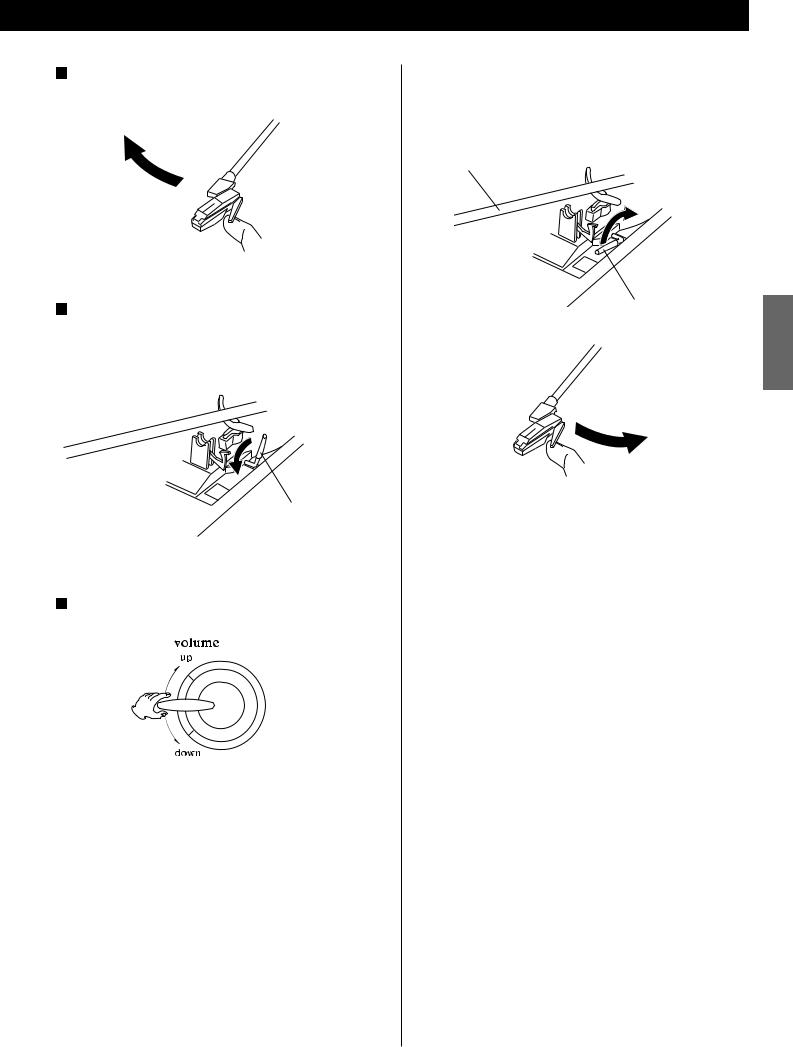
7Move the tone arm gently to the edge of the record (or the starting point of a track).
The turntable will begin to turn.
8Gently lower the tone arm by slowly releasing the cue lever.
You can lower the tone arm manually if the cue lever has not been raised.
cue lever
9 Turn the VOLUME knob to adjust the volume.
<Playing records with the turntable cover down will prevent dust from settling on the turntable.
Please do not place anything on top of the turntable cover, especially while playing a record.
When the playback has been finished, slightly lift the tone arm using the cue lever and return it to the tone arm holder.
The rotation stops.
tone arm
cue lever
ENGLISH
15
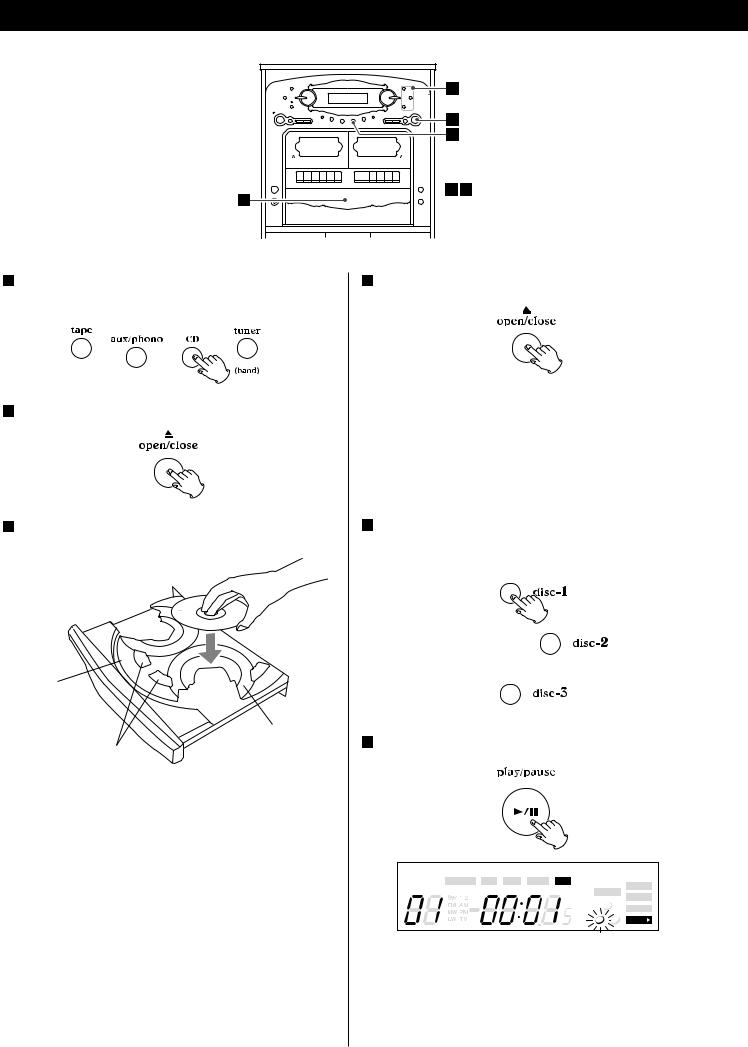
Listening to CDs
3
1Press the CD button (or the FUNCTION button of the remote control unit) to select "CD".
2 Press the OPEN/CLOSE button.
3 Place a disc on a tray with the printed label face up.
carousel
tray
disc number
<Never place more than one disc on a tray.
<To place a disc on the hidden tray, press the DISC SKIP button.
<Do not touch the carousel while it is rotating.
5
6
1
 2 4
2 4
 DISC SKIP
DISC SKIP
4 Press the OPEN/CLOSE button to close the tray.
<It takes a few seconds for the unit to load the disc. No buttons will work during loading. Wait until the total number of the tracks and the total play time of the disc are displayed.
<When no disc is set, "NO DISC" blinks.
5If you want to select other disc, press the corresponding button (DISC 1, 2 or 3) or the DISC SKIP button.
Playback starts automatically.
6 Press the PLAY/PAUSE button to start playback.
CH |
INTRO REPEAT SHUFFLE REMAIN |
TIMER |
|
|
CLASSIC |
||||
|
|
|
||
TRACK |
MEMORY AUX TAPE TUNER CD |
ON OFF |
|
ROCK
STEREO
POPS
|
|
3 |
FLAT |
|
MHz |
|
|
||
1 |
2 |
PLAY |
||
kHz |
||||
|
|
|
Playback starts from the first track of the selected disc.
When the playback of all the discs has finished, the unit stops automatically.
16
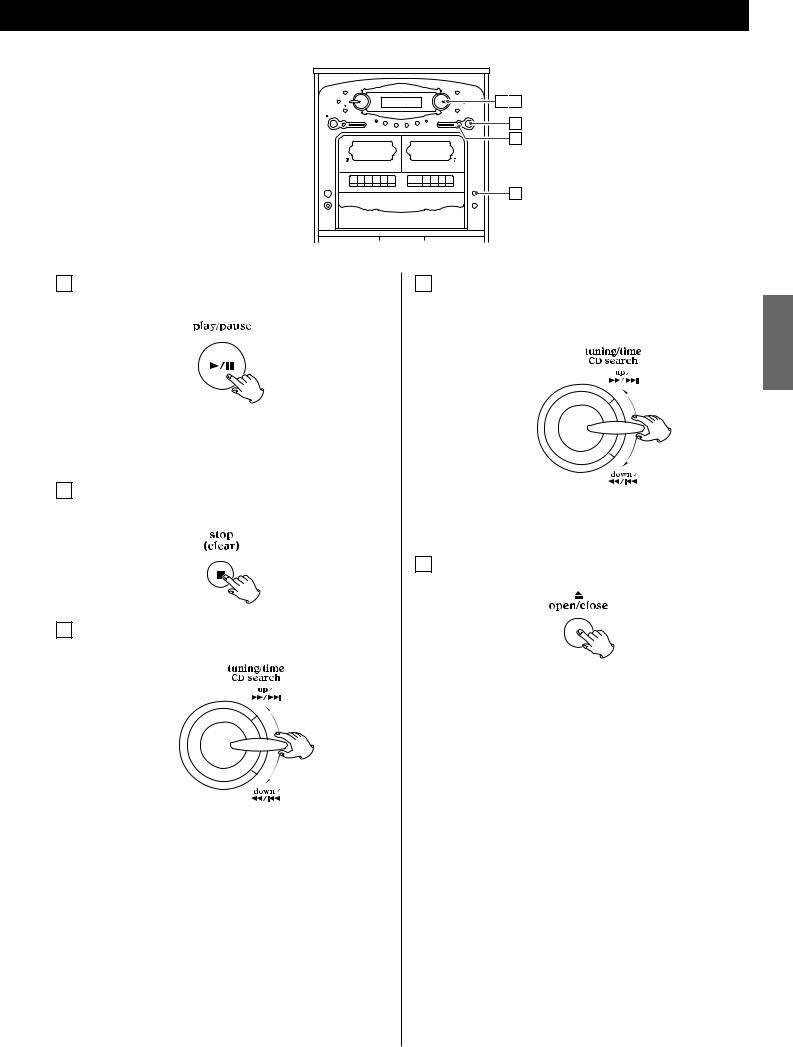
ATo suspend playback temporarily (pause mode)
Press the PLAY/PAUSE button during playback. Playback stops at the current position. To resume playback, press the PLAY/PAUSE button again.
B To stop playback
Press the STOP button to stop playback.
C To skip to the next or a previous track
During playback, tap the SKIP knob up or down repeatedly until the desired track is found. The selected track will be played from the beginning.
In the stop mode, hold up or down the SKIP knob (or tap the knob repeatedly) and release it when the track you want to listen to is found. Press the PLAY/PAUSE button to start playback from the selected track.
<When the SKIP knob is tapped up during playback, the track being played will be played from the beginning. To return to the beginning of the previous track, tap the knob up twice.
<During programmed playback, the next or previous track in the program is played.
C
 D
D
A
B
E
D Search for a part of a track
During playback, hold up or down the SKIP knob and release
it when the part you want to listen to is found. |
ENGLISH |
|
E Change discs during playback
You can change discs that aren't being played, even if another disc is being played. Press the OPEN/CLOSE button to open the tray, change the disc, and press the OPEN/CLOSE button again to close the tray.
17
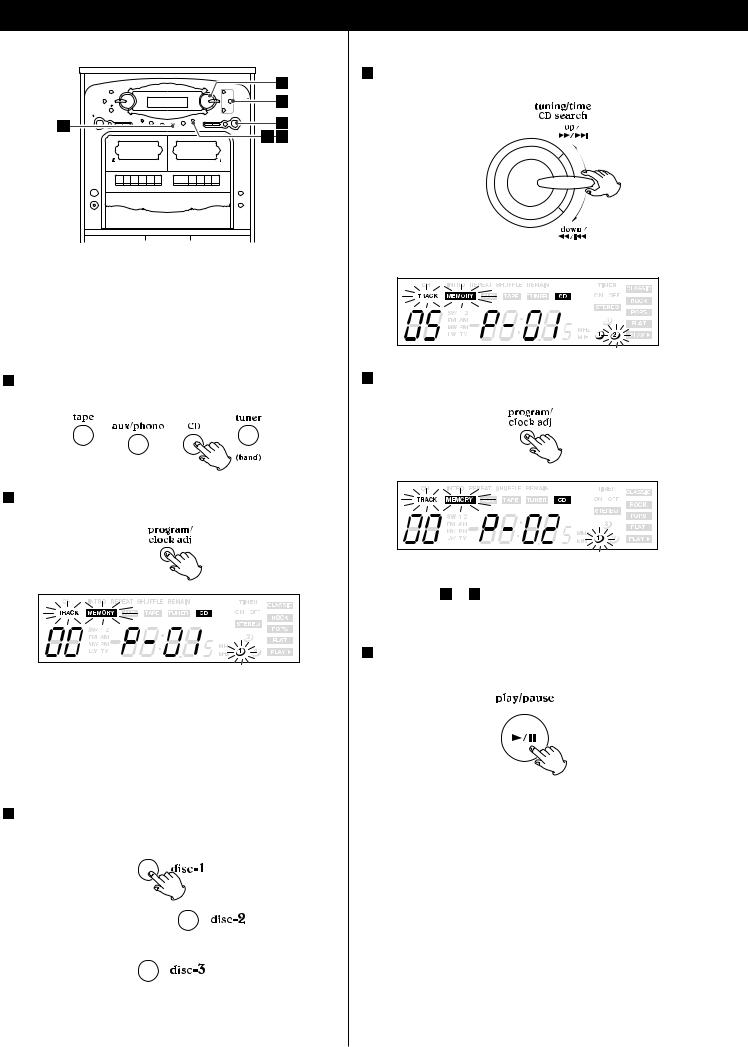
Programmed Playback
|
4 |
|
3 |
1 |
6 |
|
2 5 |
Up to 20 tracks from 3 discs can be programmed in the desired order.
Shuffle, Repeat and Intro check functions don’t work during programmed playback.
1 Press the CD button or the FUNCTION button to select "CD".
2 Press the PROGRAM button.
"TRACK", "MEMORY", and the current disc number blinks on the display.
<To cancel the program mode, press the STOP button.
<When no button is pressed for 10 seconds, the program mode will be cancelled.
3If you want to select another disc, press the corresponding button or the DISC SKIP button.
4 Tap up or down the SKIP knob repeatedly to select a track.
5 Press the PROGRAM button.
The track is programmed, and "P-02" is displayed.
< Repeat step 3 to 5 to program more tracks. < You can program up to 20 tracks.
6When the selection of track numbers is completed, press the PLAY/PAUSE button to start program playback.
<If the PLAY/PAUSE button isn't pressed within 10 seconds, the MEMORY indicator will go off. In that case, press the PROGRAM button and then press the PLAY/PAUSE button to start program playback.
<When the playback of all the programmed tracks has finished, or if one of the following buttons is pressed, the MEMORY indicator will go off and the program mode will be cancelled:
STOP, FUNCTION (TAPE, AUX/PHONO, TUNER), POWER DISC SKIP, DISC 1,2,3
But the programmed contents aren't lost. You can return to the programmed playback by pressing the PROGRAM button and the PLAY button. (If another source was selected, press the CD button beforehand.)
18
